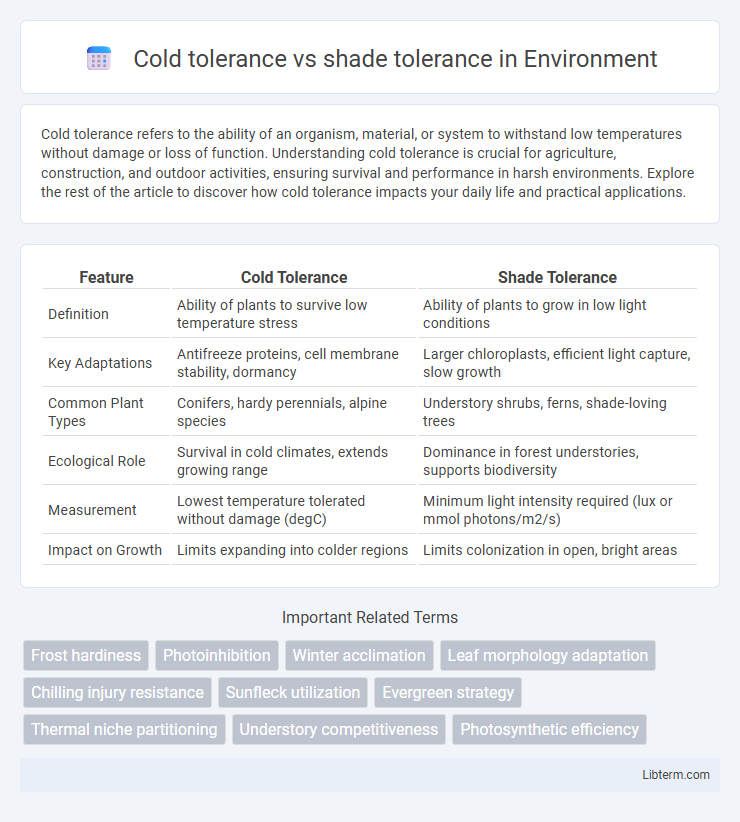Cold tolerance refers to the ability of an organism, material, or system to withstand low temperatures without damage or loss of function. Understanding cold tolerance is crucial for agriculture, construction, and outdoor activities, ensuring survival and performance in harsh environments. Explore the rest of the article to discover how cold tolerance impacts your daily life and practical applications.
Table of Comparison
| Feature | Cold Tolerance | Shade Tolerance |
|---|---|---|
| Definition | Ability of plants to survive low temperature stress | Ability of plants to grow in low light conditions |
| Key Adaptations | Antifreeze proteins, cell membrane stability, dormancy | Larger chloroplasts, efficient light capture, slow growth |
| Common Plant Types | Conifers, hardy perennials, alpine species | Understory shrubs, ferns, shade-loving trees |
| Ecological Role | Survival in cold climates, extends growing range | Dominance in forest understories, supports biodiversity |
| Measurement | Lowest temperature tolerated without damage (degC) | Minimum light intensity required (lux or mmol photons/m2/s) |
| Impact on Growth | Limits expanding into colder regions | Limits colonization in open, bright areas |
Understanding Cold Tolerance: Key Concepts
Cold tolerance in plants refers to their ability to survive and thrive at low temperatures by employing mechanisms such as antifreeze protein production, membrane stabilization, and metabolic adjustments. This adaptation involves acclimation phases where exposure to gradual temperature drops enhances frost resistance, critical for species in temperate and alpine regions. Shade tolerance, by contrast, primarily focuses on a plant's capacity to photosynthesize efficiently under low light, involving morphological and physiological traits distinct from cold tolerance strategies.
Defining Shade Tolerance in Plants
Shade tolerance in plants refers to the ability to thrive in low-light conditions by efficiently capturing and utilizing limited sunlight for photosynthesis. These plants exhibit adaptations such as larger chloroplasts, thinner leaves, and altered leaf orientation to maximize light absorption in shaded environments. Cold tolerance, by contrast, involves physiological mechanisms enabling survival at low temperatures, often unrelated to light availability, highlighting distinct adaptive strategies for environmental stress.
Physiological Mechanisms Behind Cold Tolerance
Cold tolerance in plants involves physiological mechanisms such as membrane lipid composition adjustments that maintain fluidity at low temperatures, production of antifreeze proteins that inhibit ice crystal formation, and accumulation of osmoprotectants like proline and sugars to prevent cellular dehydration. These adaptations stabilize cellular structures and metabolic processes during freezing stress. In contrast, shade tolerance primarily relies on modifications in photosynthetic pigments and leaf anatomy to optimize light capture rather than cold resilience.
Adaptations Enabling Shade Tolerance
Shade tolerance adaptations primarily involve enhanced chlorophyll concentration and increased efficiency of photosystem II, allowing plants to maximize light capture under low irradiance. Morphological traits such as larger, thinner leaves with higher chlorophyll content and altered leaf anatomy reduce light scattering and optimize light absorption. Physiological adjustments, including slower growth rates and resource allocation to maintenance rather than rapid expansion, contribute to survival in shaded environments.
Environmental Factors Influencing Cold and Shade Tolerance
Cold tolerance and shade tolerance in plants are significantly influenced by environmental factors such as temperature, light intensity, and soil moisture levels. Low temperatures trigger biochemical changes in cold-tolerant species, enhancing antifreeze protein production and membrane stability, while shade-tolerant plants optimize chlorophyll concentration and leaf morphology to maximize photosynthesis under low light. Soil nutrient availability and humidity further modulate these tolerances by affecting metabolic rates and stress responses in both cold- and shade-adapted plants.
Genetic Basis of Tolerance: Cold vs Shade
Cold tolerance in plants is primarily governed by genes involved in antifreeze protein production, membrane lipid composition, and stress-responsive transcription factors such as CBF/DREB, which regulate cold acclimation pathways. Shade tolerance relies on genetic mechanisms controlling chlorophyll concentration, photoreceptor sensitivity (e.g., phytochromes and cryptochromes), and changes in leaf morphology to optimize light capture under low irradiance. These distinct genetic bases reflect adaptation to abiotic stressors, where cold tolerance emphasizes cellular protection from freezing damage while shade tolerance enhances photosynthetic efficiency in limited light environments.
Trade-offs Between Cold Tolerance and Shade Tolerance
Plants exhibiting high cold tolerance often possess physiological adaptations such as antifreeze proteins and altered membrane compositions that enhance survival in low temperatures, yet these adaptations can reduce their efficiency in low-light conditions. Conversely, shade-tolerant species optimize photosynthetic pathways to capture limited light, frequently resulting in reduced frost resistance and slower metabolic rates which limit cold endurance. This trade-off reflects an evolutionary balance where energy allocation favors either extreme cold survival or efficient light utilization, influencing species distribution in varying climatic and canopy environments.
Species Examples: Contrasting Cold and Shade Adaptations
Conifer species like Picea abies (Norway spruce) exhibit strong cold tolerance, thriving in subarctic climates with adaptations such as needle antifreeze proteins and dormancy. In contrast, shade-tolerant broadleaf species like Fagus sylvatica (European beech) specialize in low-light environments by optimizing chlorophyll concentration and leaf architecture for efficient photosynthesis under canopy shade. These species exemplify contrasting evolutionary strategies for survival, with cold tolerance focusing on freeze resistance and metabolic downregulation, while shade tolerance emphasizes maximizing light capture and minimizing photoinhibition.
Ecological Implications of Tolerance Traits
Cold tolerance enables plants to survive and reproduce in low-temperature environments, influencing species distribution in temperate and alpine ecosystems. Shade tolerance affects a plant's ability to photosynthesize under low light conditions, shaping understory community structure in forests. The interplay of these traits determines competitive dynamics, biodiversity, and ecosystem resilience against climate variability.
Applications in Forestry, Agriculture, and Conservation
Cold tolerance enables species to survive and grow in low-temperature environments, crucial for forestry in boreal and temperate regions where frost resistance impacts tree species selection and yield. Shade tolerance determines plant capacity to thrive under low light, influencing underplanting strategies, crop spacing in agriculture, and forest regeneration management for biodiversity conservation. Integrating cold and shade tolerance traits supports adaptive management practices, improving resilience and productivity in agroforestry systems and habitat restoration projects.
Cold tolerance Infographic

 libterm.com
libterm.com